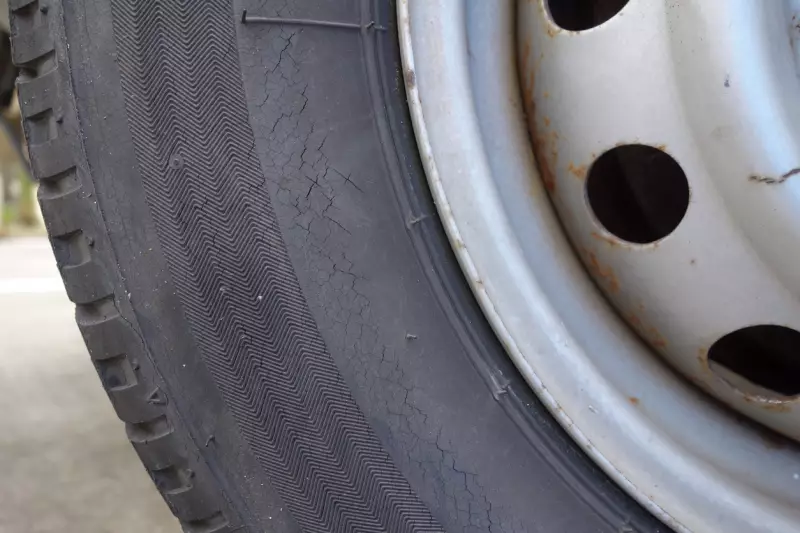Managing a vehicle so that it performs up to its capabilities and beyond takes an owner who understands the vital importance of maintenance on a regular schedule. All systems should be checked for damage, leaks, and corrosion.
Vital systems such as the drivetrain and engine have several points of contact to maintain the components for long-term use. One of the more unsuspecting problems drivers face is Tire Dry Rot. The NHTSA says over 11,000 accidents occur because owners downplay the risks of faulty tires.
What is Dry Rot on Tires?
Tire problems can be expensive for the life of the vehicle if not maintained properly. Tire dry rot is the appearance of small cracks or splits in the sidewalls of your tire. It's a significant problem on any vehicle left untreated and exposed to prolonged sunlight or age-related wear. Maintaining a healthy set of tires takes common sense and knowledge of what to look for when you think about dry rot on your tires.
What Causes Dry Rot On Tires?
Dry rot on tires is primarily caused by prolonged exposure to environmental factors like sunlight, ozone, and fluctuating temperatures. For example UV rays from the sun break down the rubber compounds, leading to cracks and weakening the tire structure over time. Age is another major factor, as tires naturally degrade and lose elasticity, even if they aren't in regular use. Additionally, infrequent driving or long periods of inactivity can contribute to dry rot on tires, as the lack of movement prevents the tire’s natural oils from distributing evenly, which helps keep the rubber flexible.
What Does Dry Rot Look Like on Tires?

Dry rot on tires appears as small cracks or splits along the sidewalls and tread. These cracks can start as barely noticeable but tend to spread, giving the tire a brittle, weathered look. The rubber may appear faded or dull, losing its usual flexibility and sheen. In advanced cases, pieces of the rubber may begin to flake off, signaling severe deterioration.
How to Prevent Dry Rot on Tires
Obvious signs of a significant dry rot problem with your tires are small cracks or splits in the sidewalls. To prevent dry rot on tires try to avoid the following conditions and long-term tire abuse:
- Long-term contamination of abrasive or corrosive chemicals and materials. Common home chemicals can include pool treatment chemicals, stored motor oils, and industrial cleaning solutions.
- Long-term exposure to direct sunlight and/or long periods of high temperatures. Also, the reverse is true: long-term exposure to frigid temperatures
- Cars and trucks stored for long periods often have extremely dry rotted tires.
- Underinflated tires are a significant cause of tire dry rot. Not keeping enough air in the tires causes too much rubber to hit the road. This leads to increased friction and rubber overheating.
Dry rot in tires is a sign of rubber deterioration and the breakdown of the layers of the tire and its metal cord bans. The first sign will be short cracks along the sidewalls and tread. Tire dry rot is “NOT organic” in any way and cannot spread from one tire to the next.
Can You Drive On Dry Rotted Tires?
No, it is never safe to drive a vehicle on dry rotting tires. Smart drivers will conduct regular maintenance checks to find the beginnings of any tire dry rot. Early stages of tire dry rot can sometimes be repaired by a tire sealant.
As tires age, the rubber begins to decay in tiny cracks and creases along the sidewall and tread. When exposed to extreme weather conditions or harmful chemicals, the cracks become larger. Here are the key dangers of trying to drive on a tire with dry rot:
- Reduced Structural Integrity: Dry rot on tires leads to the deterioration of the rubber, causing it to become brittle and weak. This compromises the tire's structural integrity, making it more susceptible to blowouts and failures, especially at high speeds or under heavy loads.
- Compromised Grip and Traction: The cracking and hardening of the tire surface due to dry rot diminishes its ability to grip the road properly. This is particularly hazardous in emergency braking situations or while maneuvering, as it increases the likelihood of skidding or losing control.
- Increased Risk of Punctures and Leaks: Tire dry rot can cause small cracks to form on the tire’s surface and sidewalls. These cracks can easily turn into punctures or allow air to escape slowly, leading to under-inflation. Driving on under-inflated tires affects handling and can also lead to tire failure.
- Poor Performance in Adverse Weather Conditions: Dry rotted tires with dry rot are less effective in adverse weather conditions like rain or snow. The reduced grip can lead to hydroplaning in wet conditions and inadequate traction in snowy or icy conditions, increasing the risk of accidents.
- Impaired Ride Comfort: As the flexibility of the tire decreases due to dry rot, it can lead to a bumpier, less comfortable ride. The vibrations and harshness transmitted to the vehicle can also put additional stress on the suspension and steering components.
- Decreased Fuel Efficiency: Dry rot tires with dry rot often lose their optimal shape and tread pattern, leading to increased rolling resistance. This inefficiency requires more energy to maintain speed, thus reducing fuel economy.
- Potential for Catastrophic Tire Failure: In extreme cases, the weakened state of a dry-rotted tire can lead to catastrophic failure, such as a tire blowout. This is especially dangerous on highways and can result in loss of vehicle control, posing a severe risk to the safety of the driver and others on the road.
Can Dry Rotted Tires Be Saved?
If dry rot on the tire has been confirmed, for the long-term, the tire needs to be replaced. Short-term solutions for tires with initial stages of drying and rotting are always hitting car and maintenance forums.
Short-term Repair Alternatives
Once tire dry rot is detected, vehicle owners have only a short period of time to replace or attempt to repair the damage. One of the most common solutions is to rub a generous amount of water-based tire degreaser on the affected area. Apply the degreaser along every inch where dry rot appears. Do this twice and let the area air dry for a couple of hours. Buy water-based tire oils to condition and improve the rubber.
Tire sealants and other adhesives work well in the short term. These solutions work mainly on low-speed, tubeless tires. Another wife's tail repair solution is combining Bars Leaks liquid aluminum and antifreeze or windshield washer fluid.
Tires with advanced stages of rotting must be replaced at once. Dry rot on tires makes it impossible to drive the vehicle safely. Accelerated levels of dry rot causes the rubber to expand and break the tire apart. It is impossible to maintain a dry rotted tire due to the cracking and splits, letting air leech from the tire.
According to Discount Tire, tire dry rotting can set in as little as five years. Humid environments tend to slow down the rotting process because the rubber is not conducive to severe splintering and cracking.
Dry rot on tires is also known as sidewall cracking or tread cracks. One or more of your tires may go through dry rotting. It is important for vehicle owners to know what to look for.
Signs Of Dry Rotted Tires

Inspect your tires on a regular basis if your vehicle is going through extreme weather. Bitter cold and hot environments contribute to the dry rotting process. Have your tires and wheels inspected by a professional as soon as possible to determine if they are safe to drive.
Look For These Signs Of Dry Rot
- Tires begin to fade into a greyish color at the first signs of dry rot. Tire fading may be in combination with tread or sidewall cracking.
- Tires may appear to lose rigidity and feel brittle. Essential oils begin to leech from the tire, and small pieces of rubber may start breaking off from the tread or sidewall.
- Advanced tire dry rot appears as small cracks on the edges of the sidewalls and tread. Large dry rot happens around the hubcaps or isolated areas. Dry rot cracks appear in the sidewalls, exposing steel cords and the tire's inner layers.
- Dry rot cracks may affect your vehicle’s handling, even if there is plenty of tread depth.
It is relatively easy to spot tire dry rot because of the discoloration and differences between a new tire and one that is dry rotted.








![Best Sites to Check a Car’s History [2025 Review]](https://media.infopay.net/thumbnails/K8lMeG2QLjE46LPqZlmoi6SunKKdT5qvlaRZk6e1.webp)










![Best Sites to Check a Car’s History [2025 Review]](https://media.infopay.net/thumbnails/K8lMeG2QLjE46LPqZlmoi6SunKKdT5qvlaRZk6e1-w356.webp)
